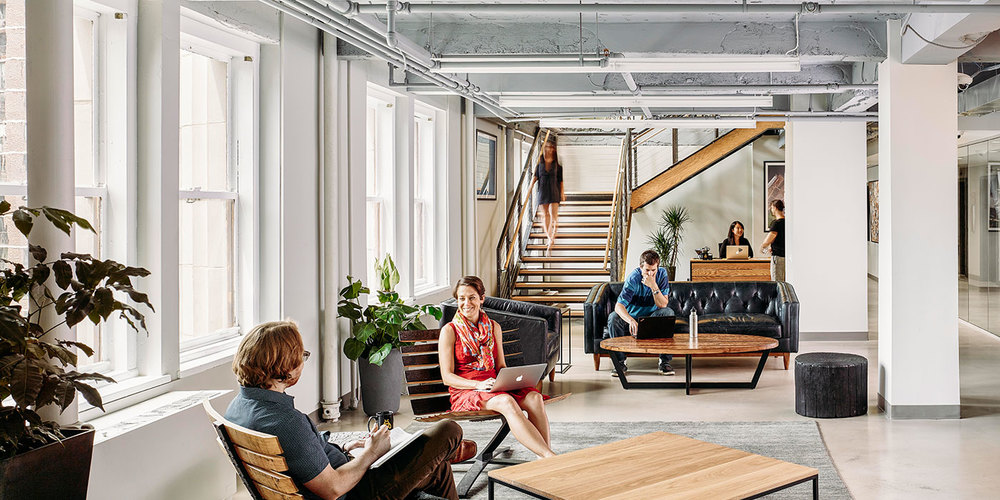For many businesses, collaboration and teamwork are an essential component of carrying out work tasks effectively, coming up with creative or innovative ideas, and helping to overcome obstacles or problems. However, collaboration is not something that just happens, it needs to be encouraged and facilitated.
It is for this reason that many businesses seek out companies offering office interior design services, in order to design and create a workplace which allows this kind of collaboration to take place. In this article, we take a look at four essential steps that can help businesses and design teams to achieve this.
1. Open Plan Areas
In recent times, the open plan layout has experienced something of a backlash, with research indicating it can be detrimental for productivity, employee health and overall happiness. However, when trying to create a successful collaborative space, open plan layouts can be essential for facilitating information and idea sharing.
The majority of criticisms of open plan office designs stem from the excessive noise created within them and lack of sound privacy afforded to employees. This leads to a number of potential problems, including heightened stress levels, more distractions, lower overall productivity and a worse standard of work being produced.
As a counter to this, however, open plan areas allow for easier interactions and an increased flow of information, because colleagues can be approached easily for discussions. Many of the disadvantages of open plan designs can also be mitigated by adding quieter areas to the office, as we will discuss later.
“A lack of walls or other physical barriers in open-plan office spaces makes it easier for employees to interact with each other on a regular basis,” says Shari Parsons Miller, writing for Chron. “Colleagues can turn to each other for advice or assistance without having to knock on doors or schedule a formal meeting.”
2. Social Spaces
Providers of the very best office interior design services go beyond the main work areas when attempting to create offices that encourage collaboration. In actual fact, one of the most important elements is the provision of dedicated social spaces, where people with completely different expertise can interact with one another away from their desk. Crucially, this allows people who work on a different floor, or in a different room, to communicate.
Samsung, for example, included several outdoor social areas in the design for their US headquarters, with the express intention of encouraging employees from different departments to interact with one another.
“The most creative ideas aren’t going to come while sitting in front of your monitor,” says Scott Birnbaum, vice president of Samsung Semiconductor. “[The Samsung office] is really designed to spark not just collaboration but that innovation you see when people collide.”
Birnbaum’s words are backed up by research carried out by the Harvard Business Review, which shows that ‘chance encounters’ or unplanned interactions by employees leads to improved business performance. In particular, the research identified that innovation and productivity could be increased by such encounters.
3. Flexible Layouts
Another great way to improve collaboration is to provide a range of different work spaces and provide employees with the freedom to move between them as they wish, depending on the nature of the work they are carrying out, their current mood and the level of concentration they need.
As previously stated, this is an effective way to offset some of the disadvantages associated with providing open plan spaces, without having to sacrifice the benefits associated with those designs.
Including private spaces within an office designed to facilitate collaboration may seem counter-intuitive, but there is logic to it. If you do not provide staff members with sufficient sound privacy when they need it, they will take steps to create it on their own. This could mean, for example, using headphones to drown out background noise.
When this occurs, staff may develop a habit of doing so even when they do not particularly need sound privacy, tuning themselves out of potential collaborative opportunities even when they are in open plan areas. By providing private areas, staff can be encouraged to seek out sound privacy only when it is most needed.
4. Office Branding
Finally, office branding is also a key part of the process of creating a collaborative office space. This might seem like an usual priority, but the branding of a workplace goes a long way towards influencing the culture that exists there, and that is important for ensuring staff know that collaboration and teamwork is desired.
“When most companies consider their brands, they rarely venture beyond the design and implementation of a logo,” says Brian Brindisi, senior associate at Gensler, in an interview with Metropolis. “A good brand does more than establish a visual language; it creates an immersive experience for every person who enters their workplace.”
Think of ways you can communicate collaboration through branding. It may be that you can achieve this through effective use of colour and company slogans. However, it is more likely that you will need to take additional steps.
One suggestion would be to include inspirational quotes about teamwork on the walls of your collaborative spaces. Additionally, company literature in the workplace can make reference to the team, rather than individuals.



